The Asia Textile Chemicals Market is estimated to be valued at USD 15912.0 million in 2025 and is projected to reach USD 28495.9 million by 2035, registering a compound annual growth rate (CAGR) of 6.0% over the forecast period.
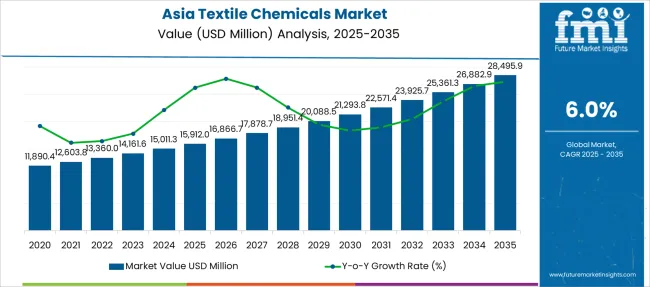
| Metric | Value |
|---|---|
| Asia Textile Chemicals Market Estimated Value in (2025 E) | USD 15912.0 million |
| Asia Textile Chemicals Market Forecast Value in (2035 F) | USD 28495.9 million |
| Forecast CAGR (2025 to 2035) | 6.0% |
The Asia textile chemicals market is experiencing consistent growth due to increased textile production, shifting consumer preferences, and technological innovations in chemical processing. Rising demand for performance textiles and functional fabrics has accelerated the need for advanced chemical formulations that improve durability, softness, water repellency, and resistance to shrinking or wrinkling.
Environmental regulations have encouraged the adoption of eco friendly and sustainable textile chemicals, pushing manufacturers to innovate in biodegradable and low toxicity solutions. The rapid expansion of textile manufacturing hubs across countries such as China, India, Bangladesh, and Vietnam continues to support volume consumption of processing chemicals.
Apparel exports and domestic fashion markets further reinforce the region’s position as a global textile processing leader, shaping strong demand for high efficiency chemical treatments across various stages of fabric production.
The market is segmented by Product Type, Process Type, and Application and region. By Product Type, the market is divided into Textile Auxiliaries and Textile Colorants. In terms of Process Type, the market is classified into Pre-Treatment, Dyeing, Finishing, and Others. Based on Application, the market is segmented into Apparels, Home Furnishings, and Others. Regionally, the market is classified into North America, Latin America, Western Europe, Eastern Europe, Balkan & Baltic Countries, Russia & Belarus, Central Asia, East Asia, South Asia & Pacific, and the Middle East & Africa.
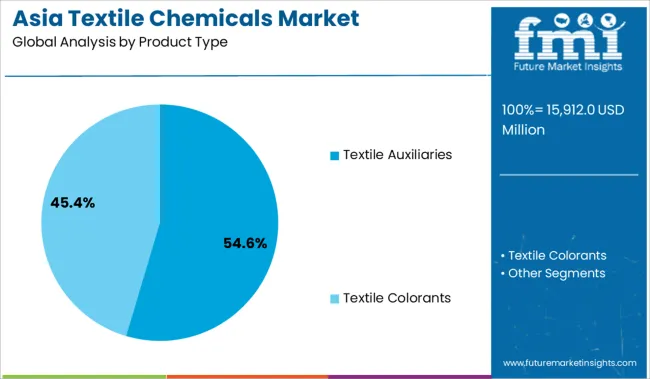
The textile auxiliaries segment is projected to represent 54.60% of the overall market by 2025 under the product type category, making it the leading contributor. This is driven by the critical role auxiliaries play in supporting dyeing, finishing, and printing processes.
These chemicals enhance fabric characteristics such as feel, appearance, and technical performance. Their increasing application in producing functional textiles and in meeting strict export quality standards has elevated their importance across textile supply chains.
Additionally, demand for multipurpose and sustainable auxiliaries has encouraged product innovation, further strengthening their dominance within the product landscape.
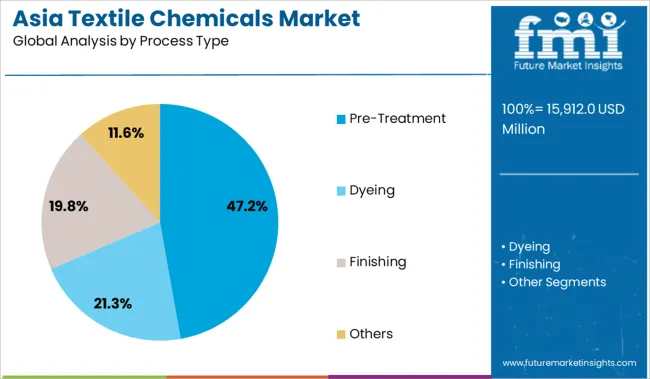
Within the process type category, the pre treatment segment is anticipated to hold 47.20% of market revenue in 2025. This is attributed to the essential role of pre treatment chemicals in preparing fabric for subsequent finishing processes.
Operations such as desizing, scouring, and bleaching require specialized chemicals to ensure uniform dye uptake and fabric quality. The expanding scale of automated textile processing and the need for high throughput, low defect manufacturing has increased reliance on efficient pre treatment solutions.
Continued innovation in low water and low energy consumption pre treatment chemicals is also supporting their widespread adoption in modern textile facilities.
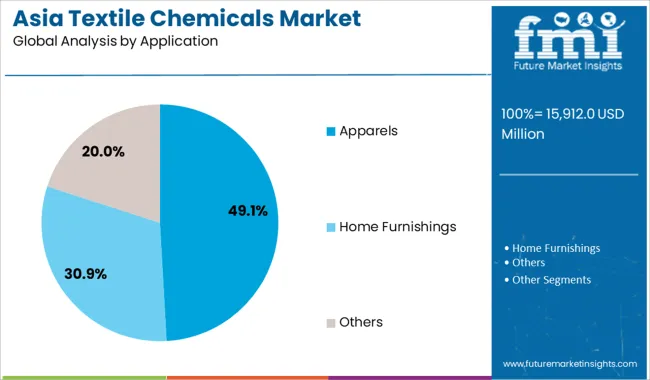
The apparels segment is expected to contribute 49.10% of the total market by 2025 under the application category, maintaining its leadership position. The dominance of this segment is supported by rising apparel exports, fast fashion trends, and increasing consumer demand for enhanced garment aesthetics and performance.
Textile chemicals used in apparel manufacturing must meet stringent performance and safety standards, especially in export driven markets. Functional enhancements such as wrinkle resistance, antibacterial finishes, and moisture management treatments have become standard expectations in apparel, further driving the consumption of specialty chemicals.
As apparel production continues to be the backbone of Asia’s textile economy, this application segment is set to retain its influence in the regional market.
Demand for textile chemicals in many Asian countries has been increasing significantly, as leading manufacturers are collaborating with global apparel industry market players for revenue generation. As sustainability concerns gain precedence, textile chemical manufacturers would focus on adopting sustainable chemical management to enable less consumption of water and energy.
Thanks to the ever-expanding textile and apparel industry, the adoption of textile chemicals has burgeoned in the last couple of years. As per FMI’s analysis, the Asia textile chemicals market recorded a year-on-year (Y-o-Y) growth of 6.7% from 2024 to 2024.
Increasing demand for textile chemicals across China, India, and Japan within the apparel industry has bolstered growth. Increasing export-import textile chemicals supply chain across the globe is expected to also aid the demand. Demand for textile chemicals is not limited to the apparel industry alone, as textile chemicals are extensively used in floor covering and home furnishings. Burgeoning demand for textile chemicals from the construction and medical industry would also propel the growth.
With extensive use of textile chemicals within diverse end-use sectors while developing eco-friendly chemicals, it is anticipated that the market is predicted to register a steady growth at 6% CAGR between 2025 and 2035. As per Future Market Insights, the textile chemicals market reached a valuation of USD 13,360 Million while registering a shipment of 978 kilotons of textile chemicals in 2025.
Key players are increasing research & development (R&D) initiatives to develop microbes through proper finishing processes that are capable of manufacturing high-performance-renewable dye, catering to the demand from the apparel manufacturing industry. The cost-effectiveness of the synthetic biology method has encouraged companies to fabricate colorful dyes in the most environmental-friendly manner. Reduced water consumption with finer-quality textiles has improved the demand for eco-friendly chemicals.
Hence, sustainable chemical management is being actively adopted by manufacturers in the apparel industry. For instance, 7 leading companies have come together to launch Sustainable Chemistry for the Textile Industry, which will help retailers and manufacturers attain the highest levels of sustainability. Archroma, CHT Group, Huntsman, Kyung-In Synthetic Corporation (KISCO), Pulcra Chemicals, Rudolf Group, and Tanatex Chemicals are the leading manufacturers who have made substantial investments in sustainable solutions in recent years.
Also, the need for textile chemicals in several processes and applications is expected to support the growth in textile raw material production observed in the last few years. Such initiatives and investments in sustainable approaches are expected to widen the growth opportunities for textile chemicals manufacturers.
Stringent regulations imposed on using hazardous chemicals in the clothing and apparel industry have triggered various sustainability as well as health concerns. A couple of years back, Greenpeace’s Detox Campaign was organized, which exposed the links between textile manufacturing facilities using toxic chemicals.
Since then, key manufacturers have adopted sustainable ways to use non-toxic chemicals while curbing the wastage of water. Manufacturers in the textile chemicals market are adopting the usage of non-aqueous dyeing of cotton textiles. For health safety & in adherence to eco-friendly policy, textile manufacturers are adopting sustainable approaches through chemical management. Demand for eco-friendly chemicals, which reduces water and energy consumption in textile processing and manufacturing, has burgeoned.
With an increased focus on environmental protection in adherence to government norms, manufacturers are likely to register incremental opportunities within the apparel industry.
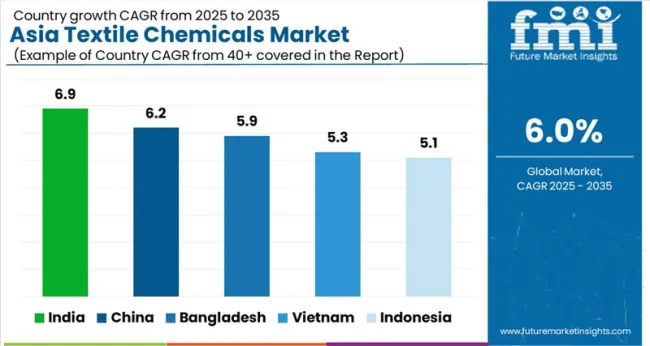
Vietnam and Indonesia are two new emerging economies and are projected to grow at a rate of 5.3% and 5.1% respectively.
| Countries | Market Share |
|---|---|
| India | 6.9% |
| China | 6.2% |
| Bangladesh | 5.9% |
| Vietnam | 5.3% |
| Indonesia | 5.1% |
China is expected to emerge as a highly lucrative market for textile chemicals, attributed to its pinnacle position in the textile & apparel industry. China is projected to cement its dominance across East Asia’s textile chemicals market, registering a 6.2% CAGR.
China is the largest clothing exporter in the world, as it has one of the largest textile & apparel industries. Recent estimates from the General Administration of Customs of China suggest that China’s textile and apparel exports accounted for USD 15011.3 Billion in January 2024, increasing 9.5% over 2020.
| Attributes | Details |
|---|---|
| Market Size (2035) | USD 15,200 Million |
| Market Absolute Dollar Growth (USD Million/Billion) | USD 6,894& Million |
With the increasing production and import-export, China’s textile & apparel industry is on the boom. Increasing investment, as well as government support, is aiding the expansion of China’s textile chemical industry, rendering it a growth of 6.2% during the forecast years. Cheaper electricity rates, lower cotton prices, and transportation subsidies are aiding the growth of the textile industry. With the onslaught of COVID-19, the production of PPE kits and masks gave an exponential boost to the textile industry.
As of May 2024, China accounted for 60% of mask production across the globe as per the Global PPE demand & supply report. An increase in the production of masks internationally & domestically enhanced the adoption of textile chemicals significantly. Based on the aforementioned factors, textile chemical manufacturers are finding lucrative growth opportunities across the country.
| Attributes | Details |
|---|---|
| Market Size (2035) | USD 3,140 Million |
| Market Absolute Dollar Growth (USD Million/Billion) | USD 1,344 Million |
With rising government initiatives for green chemicals and robust expansion of the textile & apparel industry, India’s textile chemical industry is slated to witness staggering growth over the forecast period. Increasing government focus and favorable policies are aiding the growth of the apparel & textile industry. In Union Budget 2024 to 2024, the Indian government allocated USD 109.01 million for the Amended Technology Upgradation Fund Scheme (A-TUFS).
Increasing demand for textiles and apparel across the country is expected to bolster the adoption of textile chemicals, improving demand. Demand for apparel has increased with growing consumer preference for foreign textile brands.
India’s textile industry is anticipated to reach around USD 15011.3 Billion by 2024, states the Indian Brand Equity Foundation (IBEF), employing over 45-60 million people. Indian textile and apparel industry is one of the largest contributors to the export, with around 13.5% of total export reaching USD 42.44 Billion. Hence, textile brand manufacturers, including Raymond Limited, Vardhman Group, and Aditya Birla Fashion & Retail, are increasing the adoption of textile chemicals catering to the demand.
With the ever-expanding apparel industry, India is expected to be a hotspot for textile chemicals manufacturers.
India’s textile chemicals market sales are set to proliferate at 11% CAGR during the forecast period, opines Future Market Insights. Leading countries of the region, such as China and India, are emphasizing the adoption of cutting-edge technology and manufacturing processes in a variety of industrial areas, which has accelerated the growing consumption of technical textiles across a variety of industrial sectors.
| Attributes | Details |
|---|---|
| Market Size (2035) | USD 1,110 Million |
| Market Absolute Dollar Growth (USD Million/Billion) | USD 460 Million |
The textile chemicals market is poised to accrue significant gains across Bangladesh. According to the report, the key factor driving the textile chemical market in Bangladesh is the existence of a fully developed textile export base.
With Bangladesh being a prominent exporter of the textile industry in the world, the market for textile chemicals reached around USD 615 Million in 2024. The Bangladesh textile chemical market is estimated to be around USD 15912 Million in the present year 2025 and would register a CAGR of 5.5% through 2035. As such, the growing demand for Bangladesh textiles and apparel around the world is figured out to be the key factor driving the textile chemical market in the country as well. As per FMI’s analysis, Bangladesh is anticipated to contribute significantly to the textile chemicals market, witnessing steady growth over the forecast period.
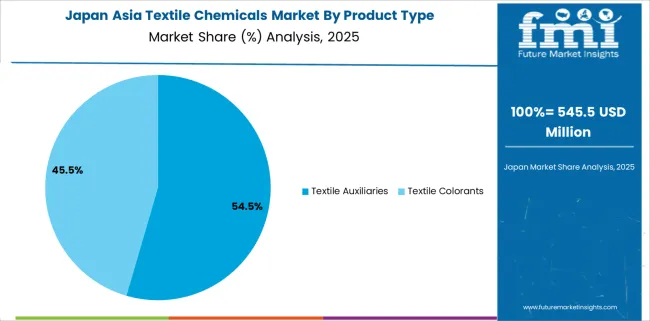
Growing demand for sustainable and non-toxic fabrics across Japan has led manufacturers to increase research & development activities for eco-friendly solutions. Manufacturers are adopting non-aqueous dyeing of cotton textiles to curb the wastage of water.
For health & environmental benefits, manufacturers are adopting responsible manufacturing approaches through sustainable chemical management. With that, increasing demand for textiles & apparel has provided an impetus to the market growth.
In 2024, the USA imported around USD 1.7 million in textiles from Japan while exporting textiles across the globe totaling USD 640 billion in 2024, as per Annual International Trade Statistics.
The rapid growth of the textile & apparel industry has driven textile chemical manufacturers to form an alliance with apparel industry key players for lucrative revenue generation. Thus, with the growing adoption of textile chemicals, the textile chemicals market across Japan is anticipated to register positive growth.
Based on the product type, textile auxiliaries, and textile colorants segments are evenly poised in the Asia textile chemicals market. Textile auxiliaries are specifically used in the process of fabric manufacturing.
Demand for specific functional finishes for textiles and apparel has led to the demand for textile auxiliaries, propelling segment growth. During the assessment period, demand for textile auxiliaries is expected to witness faster growth as compared to textile colorants.
Textile auxiliaries are estimated to maintain their leading position with impressive growth at nearly 10% CAGR, while textile colorants may lag behind by 1% during the forecast period.
By process, the finishing process segment is projected to experience faster growth than that of pre-treatment, dyeing, and other segments. The chemical finishing process, also known as the beautification process, is highly versatile and have various finishing process for different type of fabrics.
The compatibility and durability fabrics get with the finishing process can result in a desirable product suitable for laundering as well as dry cleaning. Various chemical finishing processes such as anti-soil finish, parchmentising, and wrinkle-free finish are widely in demand.
Textile manufacturers prefer anti-microbial, water-repellants, and other finishing processes catering to the demand for high-quality fabric. Such factors provide stimulus to the segment demand. Backed by the soaring demand for textiles and apparel with specific functional finishes, the segment is slated to register stellar growth at 10.6% CAGR through 2024.
By application, textile chemicals for apparel are likely to account for the largest revenue over the forecast period. Rising disposable income and increasing population have led to a spike in the consumption of apparel, especially casual wear, and sportswear.
This, in turn, has created a robust demand for textile chemicals in the apparel segment. Future Market Insights projects the apparel segment is slated to register healthy growth at nearly 8.8% CAGR over the forecast period. Soaring demand for foreign textiles brands, especially in low-to-middle-income countries such as India, China, and Bangladesh, has amplified the export & import of textile chemicals. Demand for apparel has increased with the digitization and penetration of social media sites, aiding the sales of garments across the globe.
Apparel manufacturers across the globe, especially in India, Bangladesh, and China, are witnessing robust growth backed by burgeoning consumer demand. The expansion of the apparel industry has bolstered the demand for textile chemicals. However, COVID-19 had a huge impact on the apparel industry, as offline fashion retail sales declined in the first quarter of 2024. Disruption in manufacturing activities and global shutdowns created a domino effect of revenue losses.
Manufacturers’ reliance on digital platforms and online retail sources has provided a much-needed boost for the recovery. Overall, the demand for textile chemicals is likely to augment over the coming years, thanks to the recommencement of the industry and burgeoning demand from the apparel segment.
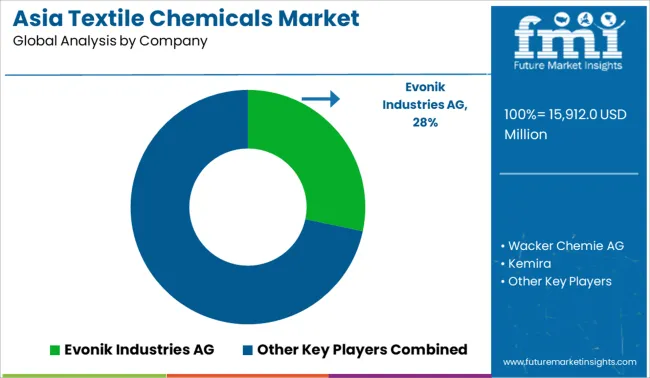
Rising demand for eco-friendly chemicals and focus on water preservation has led the market players to emphasize channelizing their efforts towards ensuring sustainability. With the demand for sustainable solutions, key players are developing innovative products catering to the need.
With the market being fragmented, top key players are dominating the textile chemicals market, contributing nearly 1/4th of the Asia market share. Due to this fragmented nature, new product launches and customized product offerings have emerged as key strategies to maintain their position in the industry.
Because of its increasing appeal and versatility, technical textile is one of the highly innovative and prominent product areas in the global as well as regional textile business. Majorly the development of the automotive and equipment for medical sectors is boosting the technical textiles market growth in the region as well.
Inorganic growth strategies such as collaborations and partnerships with top companies may translate into incremental opportunities for key players. For instance:
The global asia textile chemicals market is estimated to be valued at USD 15,912.0 million in 2025.
The market size for the asia textile chemicals market is projected to reach USD 28,495.9 million by 2035.
The asia textile chemicals market is expected to grow at a 6.0% CAGR between 2025 and 2035.
The key product types in asia textile chemicals market are textile auxiliaries and textile colorants.
In terms of process type, pre-treatment segment to command 47.2% share in the asia textile chemicals market in 2025.
Explore Similar Insights

Thank you!
You will receive an email from our Business Development Manager. Please be sure to check your SPAM/JUNK folder too.
Chat With
MaRIA